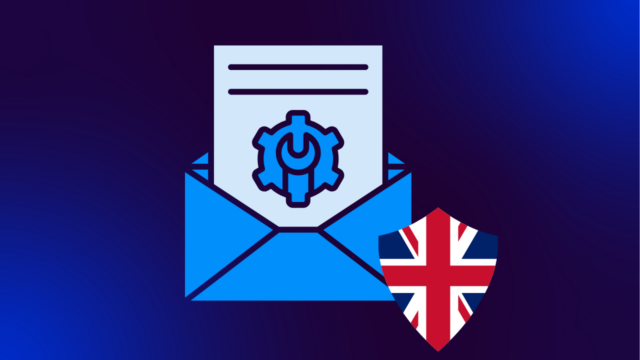Your domain reputation is the behind-the-scenes factor that determines whether your email campaigns will fly or flop. A good reputation boosts your chances of landing in the inbox, while a poor reputation can land you in the spam folder from the get-go.
Sending emails is just the beginning of your email’s journey. Your messages still need to find the inbox, attract attention, win the open, earn engagement, and drive action. It’s a nitty-gritty process with lots of steps, but everything ultimately depends on your domain reputation landing you in the inbox.
Whether you’re a seasoned email marketer looking to refine your approach or a newcomer who wants to better understand the email ecosystem, we’ve got you covered. Below, we’ll walk you through everything you need to know about domain reputation to check, improve, and protect it.
What is your domain reputation?
Your domain reputation influences whether email service providers (ESPs) let you into their clients’ inboxes. They use a score (of sorts) to judge your email practices and determine whether you’re a legitimate sender or a bad actor.
Several factors influence your domain reputation:
- Email Volume: How much email you’re sending. Like a loud voice in a quiet room, a sudden spike in volume can attract attention—sometimes, the wrong kind.
- Complaint Rates: How often recipients mark your emails as spam. This is the digital equivalent of feedback on your social etiquette—too much negative feedback, and your inbox doors will close. Google and Yahoo actually require bulk senders to keep their spam rate below .1%. However, you should avoid ever reaching a spam rate of .3% or higher.
- Spam Trap Hits: Sending emails to addresses set up to catch spammers. Get caught in a spam trap, and ESPs will know you’re not following best practices to build and engage with your email list.
- Email Engagement: How your email audience interacts with your messages. If your audience doesn’t open or click on your emails, it signals to inbox providers that your messages aren’t wanted.
Email service providers and Internet Service Providers (ISPs) monitor these factors closely and use them to decide whether emails are worthy of the inbox or should be relegated to the spam folder.
A strong reputation leads to higher email deliverability rates and ensures your messages reach their intended audience. This ultimately paves the way for better engagement, as your emails are more likely to be opened, read, and acted upon when they land in the inbox rather than the spam folder.
Without a positive domain reputation, your email campaigns are doomed to fail—regardless of your email’s quality or importance.
Domain reputation factors: What actually moves the needle
Let’s break down what actually impacts your domain reputation score:
- Sending consistency: Mailbox providers get nervous when you suddenly blast out way more emails than usual. If you typically send 1,000 emails weekly but suddenly shoot out 100,000, you’re going to raise some eyebrows. Keep your sending patterns steady and predictable.
- Engagement metrics matter most: If recipients open your emails, click links, and move messages to their primary inbox, mailbox providers see you as the cool kid. But if they’re ignoring you, deleting without opening, or worse—marking you as spam—your reputation takes a hit. Gmail and Yahoo particularly care about:
- Open rates (aim for 15-25% or higher)
- Click-through rates
- Reply rates
- How long people spend reading your emails
- Whether recipients move your emails to primary inbox
- Spam complaint rates: The fastest way to tank your reputation is racking up spam complaints. It’s like getting bad Yelp reviews—a few won’t kill you, but too many will make everyone avoid you. Keep your spam complaints under 0.1% (that’s Google and Yahoo’s new requirement). Anything above 0.3% is reputation death.
- Authentication setup: Proper authentication tells mailbox providers you’re legit and helps prevent others from damaging your reputation through spoofing.
- Infrastructure hygiene: Using clean IP addresses, maintaining proper DNS records, and having reverse DNS set up properly might sound boring, but it’s important.
- List quality: Sending to old, unengaged addresses or hitting spam traps hurts your reputation. Keep your list clean by:
- Regularly removing inactive subscribers
- Using double opt-in for new signups
- Running regular list cleaning campaigns
- Immediately honoring unsubscribes
The good news? You have direct control over these factors. Start by checking your current domain reputation (we can help with that), then work on improving the areas where you’re falling short.
How do you check your domain reputation?
You can check your domain reputation using several different tools. These platforms examine your spam complaints, email sending volume, and engagement metrics to determine how the email ecosystem views your domain.
Here are a few email domain reputation checkers you can use:
- Sender Score: Consider this the credit score for your email program. Sender Score calculates your domain’s reputation, scoring it out of 100 based on factors like spam complaints and mailing volume. The higher your score, the better your reputation.
- Google Postmaster Tools: Google Postmaster Tools provides insights into various metrics, such as spam rate, delivery errors, and more, directly from the perspective of Gmail. It’s a great tool for understanding how Google (one of the largest email service providers) views your domain.
- Valimail Domain Checker: Valimail Domain Checker checks to see if DMARC is configured on your domains. It offers insights into authentication practices and alignment to help you reach DMARC enforcement and improve your overall email security.
A healthy domain reputation is often indicated by high scores on reputation databases (typically closer to their maximum values) and positive feedback from email service providers’ diagnostic tools. This suggests your emails are generally well-received, with minimal spam complaints and strong engagement metrics.
Conversely, a poor domain reputation is marked by low scores on reputation databases and negative indicators from diagnostic tools, such as high spam complaint rates or frequent authentication failures.
Your email domain reputation directly influences your email deliverability. A healthy reputation opens doors, ensuring your messages reach their intended destinations—your audience’s inboxes. A poor reputation, however, can lead to your emails being sidelined into spam folders or blocked, significantly reducing your ability to engage with your audience.
your email program will show signs of trouble before your domain reputation tanks completely. Here are the key warning signs to watch for:
6 warning signs of a damaged domain reputation
Your email program will show signs of trouble before your domain reputation tanks completely. Here are the warning signs to watch for:
- Delivery rates suddenly drop: Your emails start bouncing more than usual, or you notice they’re taking longer to deliver. If you typically see 98% delivery rates and suddenly drop to 90% or below, something’s wrong with your reputation.
- Engagement nosedives: When your normally active subscribers go quiet, it’s a red flag. Pay attention if your open rates drop more than 2-3 percentage points below your usual average, especially if it happens suddenly.
- Authentication starts failing: Unexpected SPF, DKIM, or DMARC failures could mean someone’s spoofing your domain. This is especially concerning if you see authorization failures from IP addresses you don’t recognize.
- Blocklist appearances: Finding your domain on email blocklists is like getting multiple speeding tickets—one might be bad luck, but several suggest a pattern. Regular blocklist checks should be part of your email monitoring routine.
- Spam folder problems: When your emails land in spam folders even when sent to engaged subscribers or business partners, your reputation is likely suffering. This is particularly concerning if it happens across multiple email providers.
- Unusual sending patterns: Unexpected spikes in sending volume or emails going out at odd hours could mean someone’s hijacking your domain. Keep an eye on your DMARC reports to spot unauthorized senders early.
Notice any of these warning signs? Run a quick domain check to get a clear picture of what’s going on and what needs fixing first.
How to improve your email domain reputation
Sometimes, you’ll need to take action to address a poor domain reputation and get your score headed in the right direction. This will require a few proactive and ongoing maintenance actions. Here are a few ideas to get you started:
- Implement SPF, DKIM, and DMARC: These email authentication protocols verify that your emails are genuinely from you, building trust with email service providers and your recipients. Sender Policy Framework (SPF) prevents email spoofing, DomainKeys Identified Mail (DKIM) adds a digital signature to your emails, and Domain-based Message Authentication, Reporting, and Conformance (DMARC) ties the first two together with a set of policies and reporting mechanisms that improve and protect your domain’s reputation.
- Regularly Update Your Records: Keep your SPF, DKIM, and DMARC records up to date to ensure your emails are consistently authenticated. This helps maintain your domain’s reputation and deliverability.
- Build Lists the Right Way: Only send messages to users who have explicitly opted in to receive communications from you. This best practice complies with marketing regulations, boosts engagement, and reduces spam reports.
- Clean Your Lists Frequently: Routinely remove inactive or unengaged subscribers from your mailing list. This helps improve your engagement rates and reduces the risk of spam complaints.
- Track Opens, Clicks, and Interactions: Regularly review your email campaign metrics to understand how your audience engages with your content. High engagement rates are a positive signal to email service providers about the quality and relevance of your emails.
- Adjust Based on Performance: Use engagement data to refine your email strategy. Adjust your approach accordingly if certain types of content or sending times result in higher engagement.
- Stay Informed About Your Domain Reputation: Use domain reputation tools regularly to monitor how your domain is perceived. This will help you catch and address any issues before they escalate.
Protect your email domain reputation with Valimail
Trying to understand your domain reputation can feel like dissecting a credit score—there are a lot of nitty-gritty factors and nuances that can influence it. The best you can do is follow email-sending best practices, protect your domain with authentication solutions, and monitor performance.
Fortunately, you don’t have to do it all alone. We can help.
Valimail provides a handful of solutions designed to improve and protect your domain reputation:
- Automated Email Authentication: With Valimail, implementing and managing SPF, DKIM, and DMARC becomes downright easy. Our platform automates the authentication process, reducing the complexity and eliminating the manual errors that can compromise your domain’s integrity and reputation.
- Enhanced Visibility and Control: Gain unparalleled insights into your email ecosystem. Our dashboard provides a comprehensive overview of your email-sending practices, identifying legitimate sources and spotlighting impersonation attempts to ensure only authorized emails represent your domain.
- Proactive Reputation Management: Valimail offers tools and insights for proactive domain reputation management beyond authentication. By monitoring your domain’s standing and providing actionable intelligence, we help you avoid potential issues that could impact your email deliverability.
Ready to improve your domain reputation? You can get started for free. Sign up for Valimail Monitor to access a hassle-free monitoring solution that identifies up to 100% of your sending services by name. This helps you quickly find and authorize your senders, pinpoint bad actors, and better protect your domain.
Getting visibility into your domain is just the first step to improving its reputation. Once you identify who’s using your domain, you can lock it down to secure a good reputation and continue sending mail.



